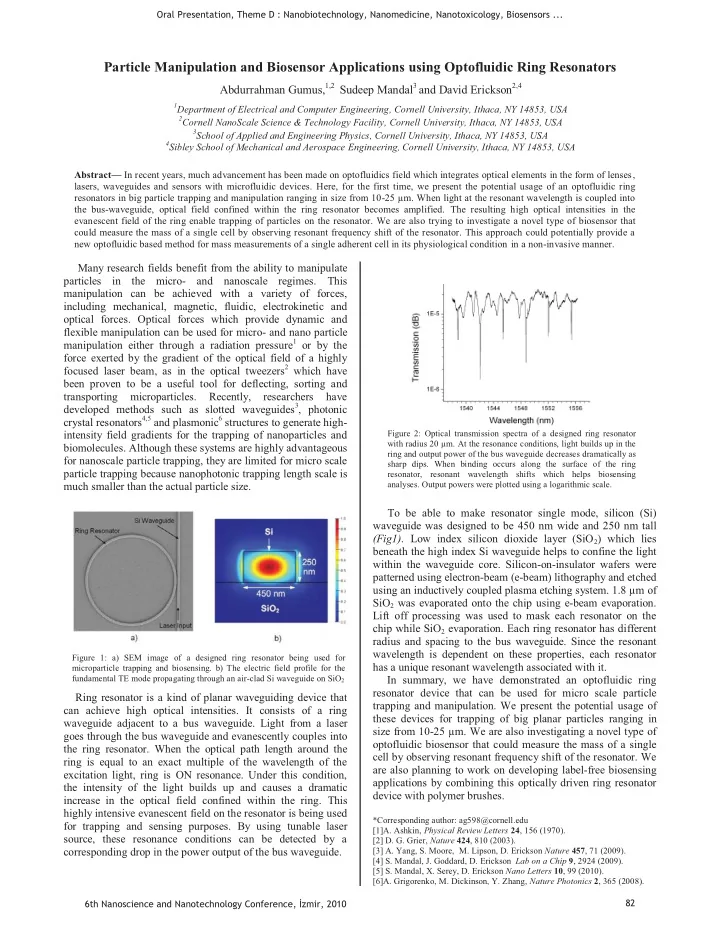

Oral Presentation, Theme D : Nanobiotechnology, Nanomedicine, Nanotoxicology, Biosensors ... Particle Manipulation and Biosensor Applications using Optofluidic Ring Resonators Abdurrahman Gumus, 1,2 Sudeep Mandal 3 and David Erickson 2,4 1 Department of Electrical and Computer Engineering, Cornell University, Ithaca, NY 14853, USA 2 Cornell NanoScale Science & Technology Facility, Cornell University, Ithaca, NY 14853, USA 3 School of Applied and Engineering Physics, Cornell University, Ithaca, NY 14853, USA 4 Sibley School of Mechanical and Aerospace Engineering, Cornell University, Ithaca, NY 14853, USA Abstract — In recent years, much advancement has been made on optofluidics field which integrates optical elements in the form of lenses, lasers, waveguides and sensors with microfluidic devices. Here, for the first time, we present the potential usage of an optofluidic ring resonators in big particle trapping and manipulation ranging in size from 10-25 μm. When light at the resonant wavelength is coupled into the bus-waveguide, optical field confined within the ring resonator becomes amplified. The resulting high optical intensities in the evanescent field of the ring enable trapping of particles on the resonator. We are also trying to investigate a novel type of biosensor that could measure the mass of a single cell by observing resonant frequency shift of the resonator. This approach could potentially provide a new optofluidic based method for mass measurements of a single adherent cell in its physiological condition in a non-invasive manner. Many research fields benefit from the ability to manipulate particles in the micro- and nanoscale regimes. This manipulation can be achieved with a variety of forces, including mechanical, magnetic, fluidic, electrokinetic and optical forces. Optical forces which provide dynamic and flexible manipulation can be used for micro- and nano particle manipulation either through a radiation pressure 1 or by the force exerted by the gradient of the optical field of a highly focused laser beam, as in the optical tweezers 2 which have been proven to be a useful tool for deflecting, sorting and transporting microparticles. Recently, researchers have developed methods such as slotted waveguides 3 , photonic crystal resonators 4,5 and plasmonic 6 structures to generate high- intensity field gradients for the trapping of nanoparticles and Figure 2: Optical transmission spectra of a designed ring resonator with radius 20 μm. At the resonance conditions, light builds up in the biomolecules. Although these systems are highly advantageous ring and output power of the bus waveguide decreases dramatically as for nanoscale particle trapping, they are limited for micro scale sharp dips. When binding occurs along the surface of the ring particle trapping because nanophotonic trapping length scale is resonator, resonant wavelength shifts which helps biosensing analyses. Output powers were plotted using a logarithmic scale. much smaller than the actual particle size. To be able to make resonator single mode, silicon (Si) waveguide was designed to be 450 nm wide and 250 nm tall (Fig1) . Low index silicon dioxide layer (SiO 2 ) which lies beneath the high index Si waveguide helps to confine the light within the waveguide core. Silicon-on-insulator wafers were patterned using electron-beam (e-beam) lithography and etched using an inductively coupled plasma etching system. 1.8 μm of SiO 2 was evaporated onto the chip using e-beam evaporation. Lift off processing was used to mask each resonator on the chip while SiO 2 evaporation. Each ring resonator has different radius and spacing to the bus waveguide. Since the resonant wavelength is dependent on these properties, each resonator Figure 1: a) SEM image of a designed ring resonator being used for has a unique resonant wavelength associated with it. microparticle trapping and biosensing. b) The electric field profile for the fundamental TE mode propagating through an air-clad Si waveguide on SiO 2 In summary, we have demonstrated an optofluidic ring resonator device that can be used for micro scale particle Ring resonator is a kind of planar waveguiding device that trapping and manipulation. We present the potential usage of can achieve high optical intensities. It consists of a ring these devices for trapping of big planar particles ranging in waveguide adjacent to a bus waveguide. Light from a laser size from 10-25 μm. We are also investigating a novel type of goes through the bus waveguide and evanescently couples into optofluidic biosensor that could measure the mass of a single the ring resonator. When the optical path length around the cell by observing resonant frequency shift of the resonator. We ring is equal to an exact multiple of the wavelength of the are also planning to work on developing label-free biosensing excitation light, ring is ON resonance. Under this condition, applications by combining this optically driven ring resonator the intensity of the light builds up and causes a dramatic device with polymer brushes. increase in the optical field confined within the ring. This highly intensive evanescent field on the resonator is being used *Corresponding author: ag598@cornell.edu for trapping and sensing purposes. By using tunable laser [1]A. Ashkin, Physical Review Letters 24 , 156 (1970). source, these resonance conditions can be detected by a [2] D. G. Grier, Nature 424 , 810 (2003). corresponding drop in the power output of the bus waveguide. [3] A. Yang, S. Moore, M. Lipson, D. Erickson Nature 457 , 71 (2009). [4] S. Mandal, J. Goddard, D. Erickson Lab on a Chip 9 , 2924 (2009). [5] S. Mandal, X. Serey, D. Erickson Nano Letters 10 , 99 (2010). [6]A. Grigorenko, M. Dickinson, Y. Zhang, Nature Photonics 2 , 365 (2008). 82 6th Nanoscience and Nanotechnology Conference, �zmir, 2010
Recommend
More recommend